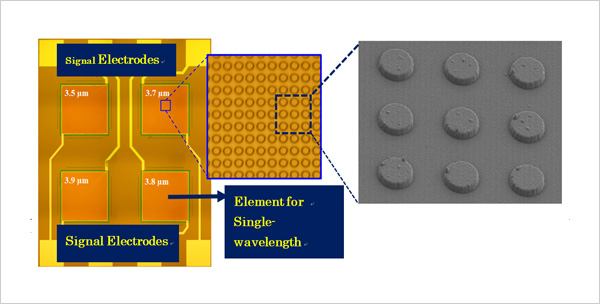 Press Release 2019
Press Release 2019
A Spectroscopic Infrared Sensor with World-Class Wavelength Resolution
— Realizing 50nm Resolution and ±1° Sensing Angle Towards the Development of Advanced Temperature and Position Sensors —
NIMS has developed a multi-wavelength infrared sensor capable of discriminating between thermal radiation of different wavelengths radiating in specific direction. With a wavelength resolution of 50 nm and a sensing angle of ±1°, this sensor may be used to remotely measure the temperatures of objects and analyze their thermal states even when their thermal radiation properties are unknown. This technology may also be applicable to the development of high-accuracy position sensors and gas sensors.
(“An On-Chip Quad-Wavelength Pyroelectric Sensor for Spectroscopic Infrared Sensing” Thang Duy Dao, Satoshi Ishii, Anh Tung Doan, Yoshiki Wada, Akihiko Ohi, Toshihide Nabatame, and Tadaaki Nagao; Journal: Advanced Science [August 26, 2019]; 10.1002/advs.201900579)
All objects on Earth are known to emit thermal radiation in the form of electromagnetic waves. The wavelength distributions of electromagnetic radiation vary depending on the types and states of the materials of which objects are composed. Current thermography and infrared cameras are incapable of discriminating between different wavelengths of electromagnetic radiation and are therefore only capable of measuring the entire electromagnetic radiation across a broad wavelength range. Due to this limitation, these devices can estimate the temperatures of human bodies and other objects relatively accurately only when their associated wavelength distributions are known in advance. Coating materials usually have unknown thermal radiation wavelength distributions, while those of semiconductors change with temperature, resulting in significant errors when currently available devices are used to measure the temperatures of these materials.
This research group developed a spectroscopic infrared (IR) sensor on a 1 cm × 1 cm silicon chip consisting of four integrated IR elements responsive to four different wavelengths. Each IR element has a slightly different surface structure, enabling it to covert electromagnetic waves of only a specific wavelength into heat, which is in turn converted into electrical signals by a pyroelectric sensor. More specifically, the IR elements’ surfaces have different arrangements of tiny, protruded structures. Adjusting these arrangements alters the wavelength each IR element absorbs and limits the IR radiation that the element absorbs to that which is perpendicular to its surface. In addition, the group fine-tuned the size and height of the protruded surface structures, increasing the wavelength resolution of the IR sensor to world-class levels, increasing its sensitivity and narrowing its sensing angle. As a result, the group developed the world’s first on-chip multi-wavelength IR sensor to possess both a high wavelength resolution (approx. 50 nm) and a narrow sensing angle (±1°) by arranging four IR elements responsive to four different wavelengths within the mid-infrared region (3.5 µm – 3.9 µm).
This technology may be applicable to the development of sensor systems with advanced analytical capabilities which could be used to remotely estimate objects’ properties, such as their thermal states and component materials. These systems may be effective in accurately measuring the temperatures of various objects, in factory production line quality management, as security sensors for homes and offices, as in-vehicle pollutant sensors and for other purposes.
This project was carried out by a research group led by Tadaaki Nagao (Group Leader, International Center for Materials Nanoarchitectonics, NIMS) with support from another research project entitled “Interface electromagnetic field controlling and thermal energy utilization by ceramics heterolayers” (Research Director: Tadaaki Nagao) conducted under the JST Strategic Basic Research Program CREST’s research field entitled “Phase interface science for highly efficient energy utilization.”
This research was published in the online journal Advanced Science on August 26, 2019.

Figure: (left) Signal electrodes, (right) Element for single wavelength.
(Regarding this research)
Tadaaki Nagao
Mana Principal Investigator, MANA, NIMS
Tel:+81-29-860-4746
E-Mail:NAGAO.Tadaaki=nims.go.jp
(Please change "=" to "@")
(Inquiries regarding JST Project)
Tsuyoshi Nakamura
Department of Research Project
Japan Science and Technology Agency (JST)
Tel:+81-3-3512-3531
Fax:+81-3-3222-2066
E-Mail:crest=jst.go.jp
(Please change "=" to "@")
(For general inquiries)
Public Relations Office
National Institute for Materials Science
1-2-1 Sengen, Tsukuba, Ibaraki, 305-0047, JAPAN
Tel:+81-29-859-2026
Fax:+81-29-859-2017
E-Mail:pressrelease=ml.nims.go.jp
(Please change "=" to "@")
Japan Science and Technology Agency (JST)
Tel:+81-3-5214-8404
Fax:+81-3-5214-8432
E-Mail:jstkoho=jst.go.jp
(Please change "=" to "@")

